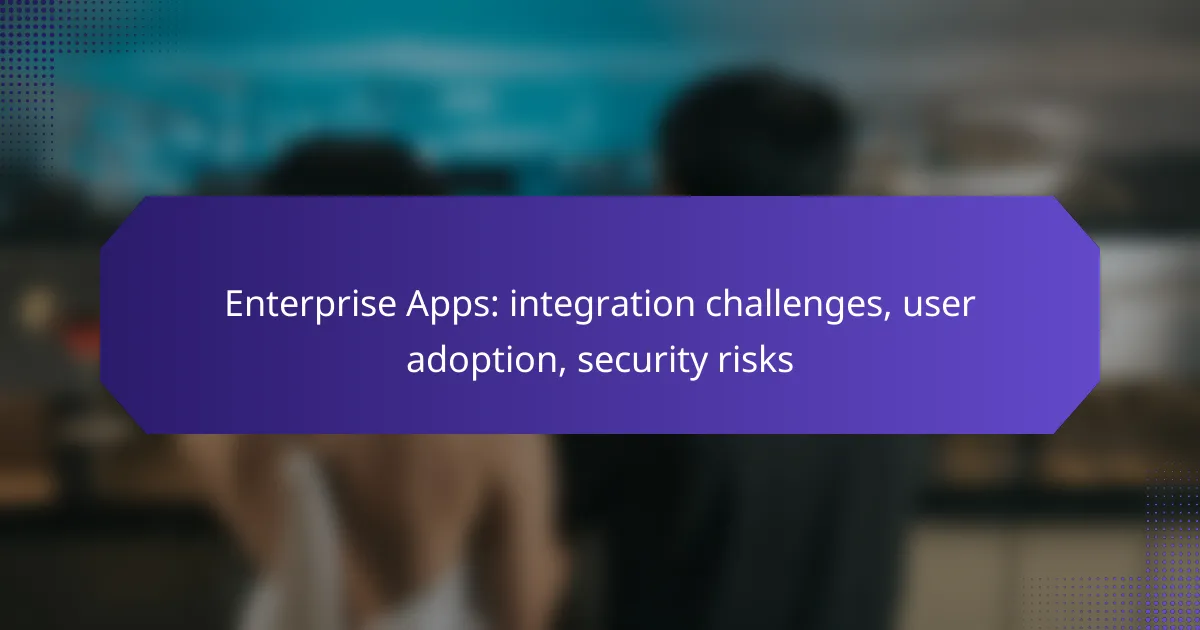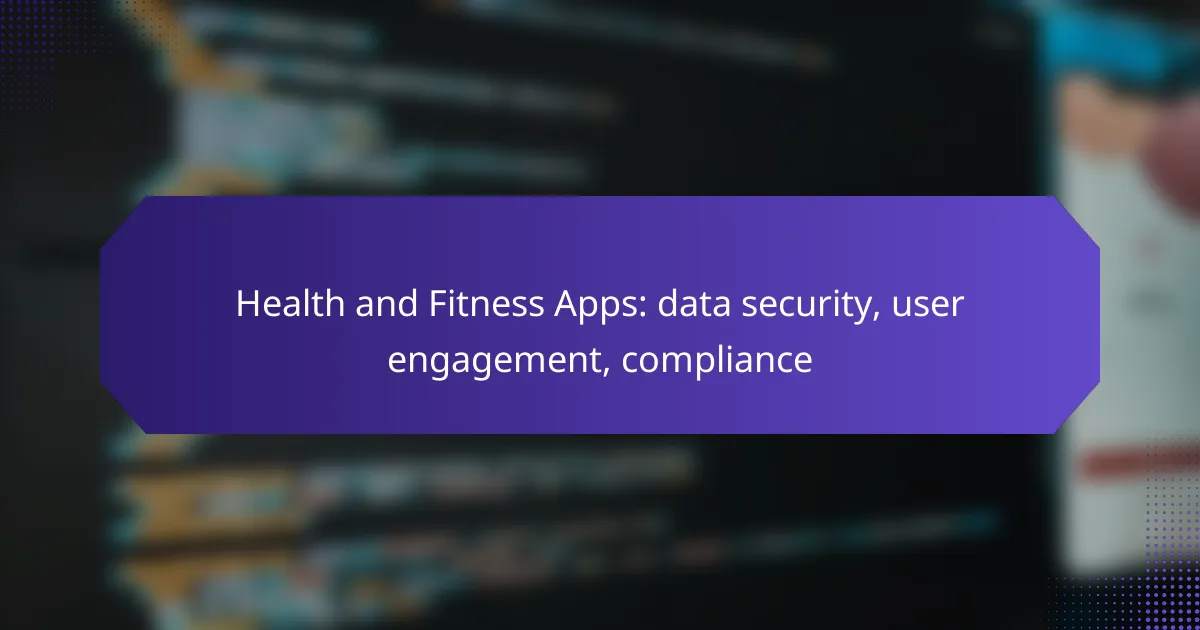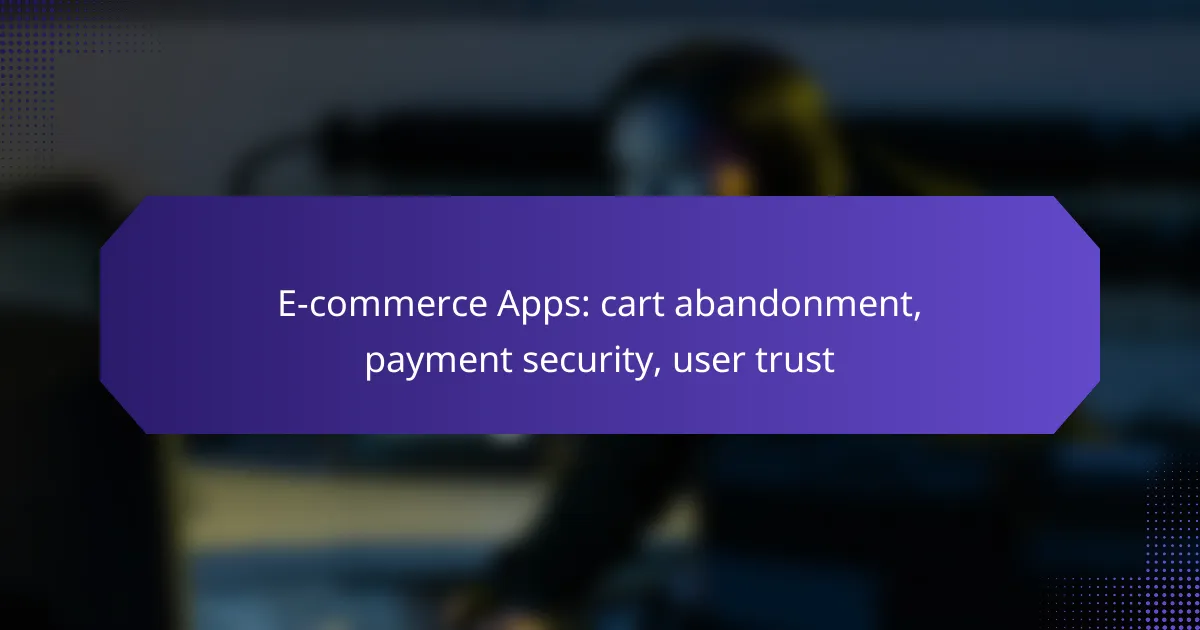Enterprise applications play a vital role in streamlining operations, yet they face significant integration challenges that can impede efficiency and user adoption. Addressing these challenges is essential for fostering a supportive environment where employees feel encouraged to engage with new technologies. Additionally, security risks such as data breaches and compliance issues pose ongoing threats that organizations must navigate to protect sensitive information and maintain system integrity.
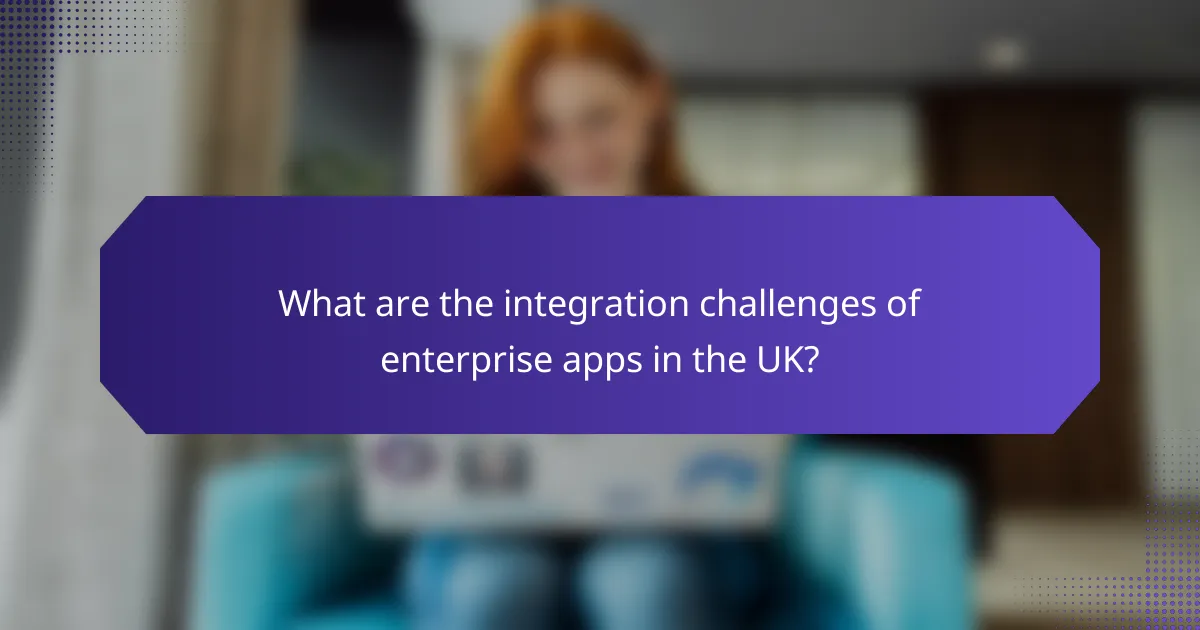
What are the integration challenges of enterprise apps in the UK?
Integration challenges for enterprise apps in the UK often stem from the need to connect various systems and data sources effectively. These challenges can hinder operational efficiency and user adoption, making it crucial for businesses to address them proactively.
Data silos and interoperability issues
Data silos occur when information is isolated within different departments or applications, making it difficult to access and share. This lack of interoperability can lead to inconsistent data, which complicates decision-making processes. Businesses should prioritize integrating their systems to ensure seamless data flow across departments.
To combat data silos, consider implementing a centralized data management platform or adopting integration middleware that facilitates communication between disparate systems. Regular audits of data accessibility can also help identify and resolve interoperability issues.
Legacy system compatibility
Legacy systems often pose significant integration challenges due to outdated technology and lack of support for modern applications. These systems may not easily connect with newer software, leading to inefficiencies and increased operational costs. Companies must evaluate their legacy systems to determine whether to upgrade, replace, or integrate them with new solutions.
When planning for integration, consider using APIs or middleware that can bridge the gap between legacy systems and modern applications. This approach can extend the life of existing systems while enhancing overall functionality.
Complexity of API management
Managing APIs can be complex, especially when multiple applications require different integration methods. Poorly managed APIs can lead to security vulnerabilities and performance issues. It’s essential for organizations to establish a robust API management strategy to ensure smooth integration and maintain security standards.
Utilizing API gateways can simplify management by providing a single point of control for monitoring and securing APIs. Regularly reviewing API performance and usage can help identify potential issues before they escalate.
Vendor lock-in risks
Vendor lock-in occurs when a company becomes overly dependent on a specific vendor’s technology, making it difficult to switch providers without incurring significant costs. This situation can limit flexibility and innovation, as businesses may feel constrained by the vendor’s offerings. To mitigate this risk, organizations should carefully evaluate vendor contracts and consider multi-vendor strategies.
Implementing open standards and avoiding proprietary technologies can help reduce the likelihood of vendor lock-in. Additionally, maintaining a clear exit strategy in vendor agreements can provide leverage for future negotiations.
Scalability concerns
Scalability is a critical consideration for enterprise apps, as businesses need to adapt to changing demands. If an application cannot scale effectively, it may lead to performance degradation and user dissatisfaction. Companies should assess their current infrastructure and integration capabilities to ensure they can accommodate future growth.
To enhance scalability, consider cloud-based solutions that offer flexible resources and can easily adjust to varying workloads. Regular performance testing and capacity planning can help identify potential bottlenecks before they impact operations.

How can enterprises improve user adoption of apps?
Enterprises can enhance user adoption of apps by focusing on effective training, gathering user feedback, designing intuitive interfaces, and providing incentives for early adopters. These strategies create a supportive environment that encourages employees to engage with new applications.
User training and onboarding programs
Implementing comprehensive training and onboarding programs is crucial for user adoption. These programs should include interactive sessions, tutorials, and easy-to-access resources that help users understand the app’s features and functionalities.
Consider using a mix of training formats, such as live workshops, recorded videos, and written guides, to cater to different learning styles. Regularly updating training materials to reflect app changes ensures users stay informed and confident in their usage.
Feedback loops for continuous improvement
Establishing feedback loops allows enterprises to gather insights from users about their experiences with the app. Regular surveys, focus groups, and one-on-one interviews can help identify pain points and areas for enhancement.
Acting on user feedback not only improves the app but also fosters a sense of ownership among users. When employees see their suggestions implemented, they are more likely to engage with the app and encourage others to do the same.
Intuitive user interface design
An intuitive user interface (UI) is essential for driving user adoption. A well-designed UI minimizes the learning curve, making it easier for users to navigate and utilize the app effectively.
Employing familiar design patterns and keeping the layout simple can significantly enhance usability. Regular usability testing with real users can help identify design flaws and areas for improvement, ensuring the app meets user needs.
Incentives for early adopters
Offering incentives for early adopters can motivate employees to engage with new applications. These incentives can range from recognition programs to tangible rewards, such as gift cards or extra time off.
Creating a sense of competition among teams or departments can also drive adoption. For example, recognizing the team with the highest engagement rates can encourage others to participate actively in using the app.

What security risks are associated with enterprise apps?
Enterprise apps face several security risks that can compromise sensitive data and overall system integrity. Key risks include data breaches, inadequate access controls, third-party integration vulnerabilities, and challenges in complying with regulations like GDPR.
Data breach vulnerabilities
Data breaches in enterprise apps can occur due to various factors, including weak encryption, outdated software, or human error. Organizations must regularly assess their security measures to identify potential vulnerabilities and implement robust encryption protocols to protect sensitive information.
To mitigate the risk of data breaches, companies should conduct regular security audits and penetration testing. Establishing a response plan for potential breaches is also crucial, ensuring that the organization can act swiftly to minimize damage.
Inadequate access controls
Inadequate access controls can lead to unauthorized access to sensitive data within enterprise apps. Implementing role-based access control (RBAC) can help ensure that users only have access to the information necessary for their job functions.
Regularly reviewing user permissions and employing multi-factor authentication (MFA) can further strengthen access security. Organizations should also educate employees about the importance of safeguarding their credentials to prevent unauthorized access.
Third-party integration risks
Integrating third-party applications with enterprise systems can introduce security risks if those applications are not properly vetted. These integrations may expose sensitive data or create new vulnerabilities that malicious actors can exploit.
To manage these risks, organizations should conduct thorough security assessments of third-party applications before integration. Establishing clear security standards and ongoing monitoring of third-party access can help maintain a secure environment.
Compliance with GDPR regulations
Compliance with GDPR regulations is critical for enterprises handling personal data of EU citizens. Non-compliance can result in significant fines and reputational damage, making it essential to understand the requirements of GDPR.
Organizations should implement data protection measures, such as data minimization and user consent protocols, to comply with GDPR. Regular training for employees on data handling practices and periodic compliance audits can help ensure adherence to these regulations.
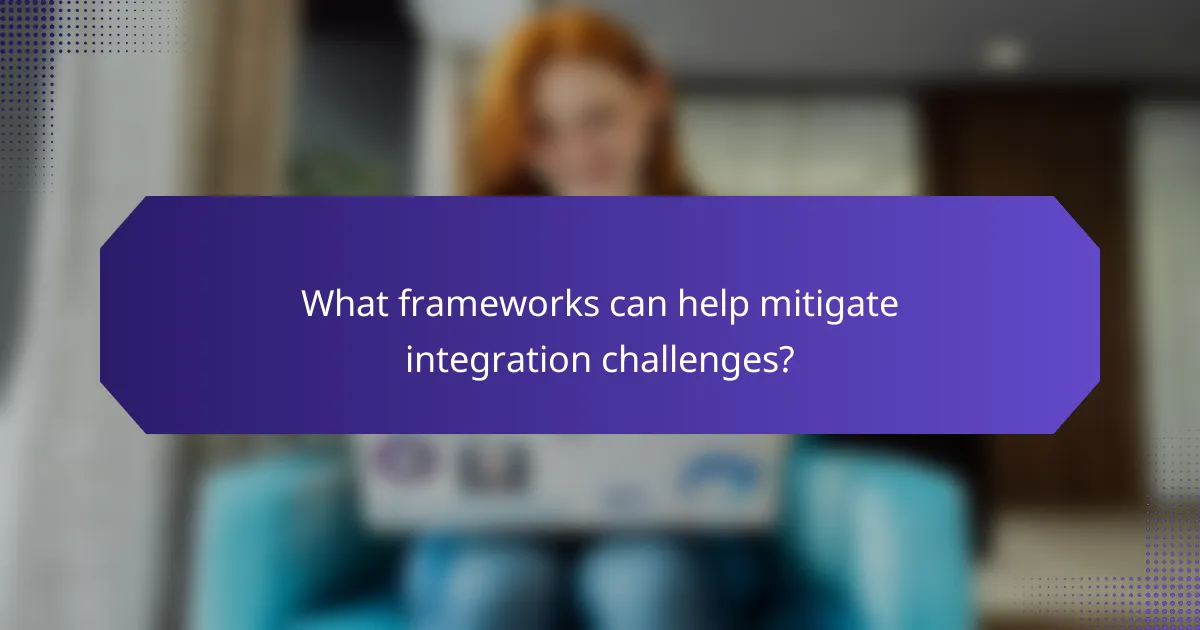
What frameworks can help mitigate integration challenges?
Frameworks designed for enterprise applications can significantly ease integration challenges by providing structured approaches and tools. These frameworks help streamline processes, enhance compatibility, and ensure security across various systems.
Enterprise Architecture frameworks
Enterprise Architecture (EA) frameworks, such as TOGAF and Zachman, offer comprehensive methodologies for aligning IT infrastructure with business goals. They provide a blueprint that helps organizations visualize their systems and identify integration points, making it easier to manage complex environments.
When implementing an EA framework, consider the specific needs of your organization. Establish clear goals and ensure stakeholder involvement to facilitate smoother integration. Regularly review and adapt the architecture to accommodate new technologies and changing business requirements.
Integration Platform as a Service (iPaaS)
Integration Platform as a Service (iPaaS) solutions, like MuleSoft and Dell Boomi, provide cloud-based tools that simplify the integration of applications and data across different environments. These platforms enable organizations to connect disparate systems quickly and efficiently, often with minimal coding required.
When choosing an iPaaS solution, evaluate its compatibility with your existing systems and the scalability it offers. Look for features like pre-built connectors and real-time data synchronization to enhance integration speed and reliability. Avoid vendor lock-in by selecting platforms that support open standards and interoperability.

How can enterprises select the right enterprise app solutions?
Enterprises can select the right enterprise app solutions by thoroughly evaluating vendor offerings, ensuring scalability, and conducting a cost-benefit analysis of features. This process helps organizations align their app choices with business needs and operational goals.
Evaluating vendor reputation
Assessing a vendor’s reputation is crucial for selecting enterprise app solutions. Look for established companies with a track record of reliability and customer satisfaction. Check reviews, case studies, and industry awards to gauge their standing in the market.
Engage with current users through forums or social media to gather firsthand experiences. This can reveal insights about customer support, software performance, and overall satisfaction that may not be evident from marketing materials.
Assessing scalability and support
Scalability is essential for enterprise apps, as businesses often grow or change over time. Choose solutions that can easily adapt to increased user loads or expanded functionality without significant additional costs. A flexible architecture can save money and time in the long run.
Support is equally important; ensure the vendor provides robust customer service options, including training, documentation, and technical assistance. Evaluate their response times and availability to ensure they can meet your organization’s needs.
Cost-benefit analysis of features
Conducting a cost-benefit analysis helps determine if the features offered by an enterprise app justify the investment. List the essential features your organization requires and compare them against the costs associated with each solution. Consider both upfront costs and ongoing expenses.
Additionally, weigh the potential return on investment (ROI) by estimating productivity gains or cost savings from improved processes. This analysis can help prioritize which features are worth the investment and which may be superfluous.
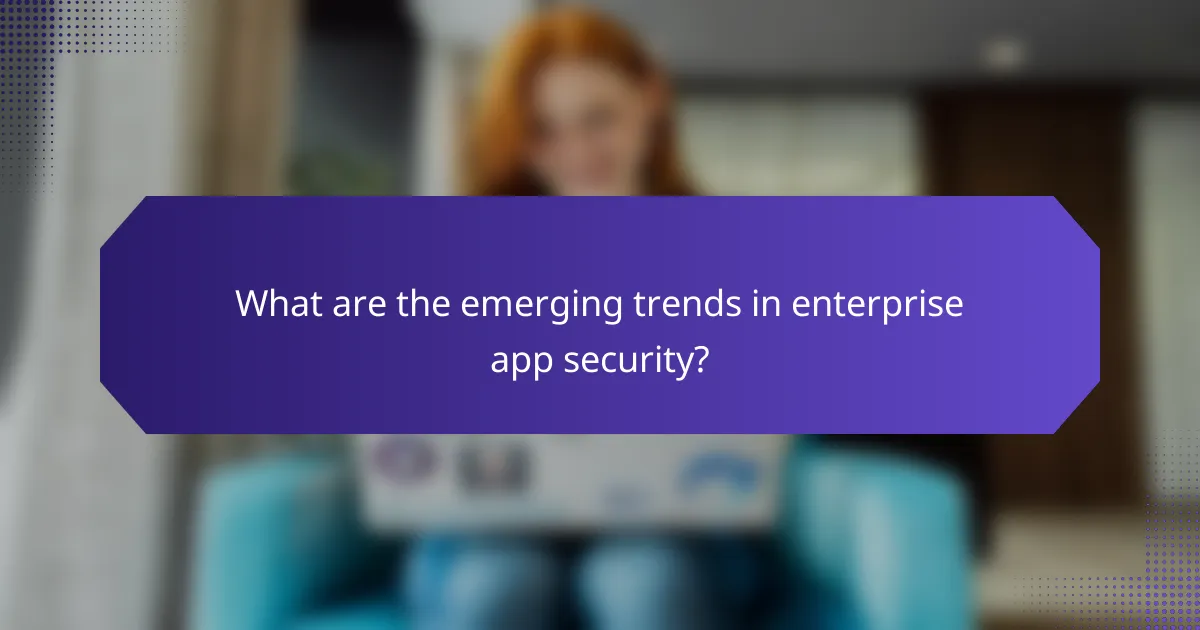
What are the emerging trends in enterprise app security?
Emerging trends in enterprise app security focus on enhancing protection against evolving threats, improving user authentication, and ensuring compliance with regulations. Organizations are increasingly adopting advanced technologies like AI and machine learning to bolster their security frameworks.
Integration challenges
Integration challenges in enterprise app security arise when aligning various systems and applications to work seamlessly together. These challenges can lead to vulnerabilities if not managed properly, as disparate systems may have different security protocols and standards.
To address integration challenges, organizations should prioritize standardization of security protocols across all platforms. Utilizing APIs and middleware can facilitate smoother integration while maintaining security integrity. Regular audits and assessments are essential to identify and mitigate potential risks.
User adoption
User adoption is critical for the success of enterprise apps, and security features can significantly impact this process. If security measures are perceived as cumbersome or intrusive, users may resist adopting the application, undermining its effectiveness.
To enhance user adoption, organizations should implement user-friendly security protocols, such as single sign-on (SSO) and multi-factor authentication (MFA). Providing training and clear communication about the importance of security can also help users feel more comfortable and engaged with the app.
Security risks
Security risks in enterprise apps can stem from various sources, including data breaches, insider threats, and inadequate security measures. These risks can have severe consequences, including financial loss and damage to reputation.
To mitigate security risks, organizations should adopt a proactive approach by regularly updating security measures and conducting vulnerability assessments. Implementing strong access controls and encryption can protect sensitive data. Additionally, staying informed about emerging threats and compliance requirements is crucial for maintaining robust security.






